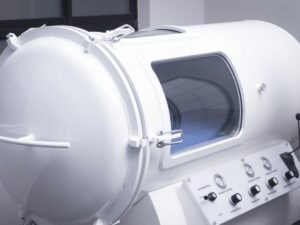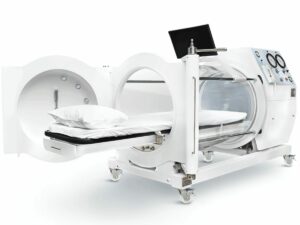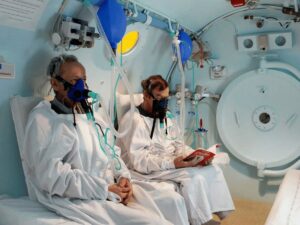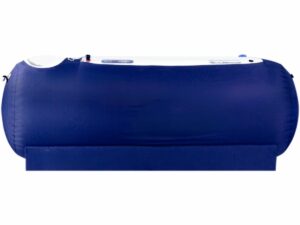Ever curious about the crucial role of a hyperbaric chamber for divers? Simply put, it’s a life-saving piece of equipment that aids in the treatment of diving-related injuries.
As an expert in hyperbaric chambers, the insights provided here are grounded in extensive experience and knowledge.
Hyperbaric chambers for divers are indispensable in ensuring divers’ safety and health. They offer an effective solution for decompression sickness and other dive-related conditions.
In this guide, we’ll dive deep into why hyperbaric chambers are essential for divers, including their benefits, types, and key considerations for choosing the right one.
Discover the life-saving importance of hyperbaric chambers for divers!
1. The Science Behind Hyperbaric Chambers
Hyperbaric chambers operate on a simple yet profoundly effective scientific principle, increased pressure allows the body to absorb more oxygen than it can at normal atmospheric conditions. Inside these chambers, air pressure is raised up to three times higher than normal. This surge in pressure causes oxygen to dissolve into the blood and tissues at a significantly enhanced rate, fostering healing and recovery processes.
Here’s the interesting part, hyperbaric chambers was first documented year 1662 when a British physician named Henshaw pioneered its use. He placed patients in a pressurized container filled with air to administer treatment, data from National Library of Medicine.

2. Medical Benefits of Hyperbaric Oxygen for Divers
Building on the science behind hyperbaric chambers, where increased pressure and oxygen absorption play key roles, here are the medical benefits of hyperbaric oxygen specifically for divers:
Accelerates Decompression Sickness Recovery
Hyperbaric oxygen is instrumental in treating decompression sickness, a serious risk for divers who ascend too quickly. The high-pressure oxygen helps dissolve nitrogen bubbles that form in the blood, facilitating a quicker and more effective recovery.
Reduces the Risk of Infections
By flooding the body with oxygen, hyperbaric oxygen strengthens the immune system’s ability to fight off infections. This is particularly important for divers who are exposed to various pathogens in different aquatic environments. It’s a shield, not just a healing tool, offering an extra layer of protection against the unseen threats lurking beneath the waves.
Improves Neurological Conditions
Lastly, and perhaps most remarkably, hyperbaric oxygen can aid in the recovery from neurological effects. For example, diving accidents, such as brain damage caused by oxygen toxicity or the bends. Improved cognitive function and reduced symptoms have been noted, which is astonishing. This demonstrates that hyperbaric oxygen potential is not just in healing the body, but in mending the mind as well.
3. Types of Hyperbaric Chambers for Divers
Following the exploration of the medical benefits of hyperbaric oxygen for divers, it becomes crucial to understand the types of hyperbaric chambers available. These chambers are designed to suit different needs and scenarios, providing divers with the necessary treatment options. Here are the primary types of hyperbaric chambers for divers:
Monoplace Hyperbaric Chambers
These chambers are designed for single occupancy, providing a controlled environment for individual treatment. They are typically cylinder-shaped, allowing for easy monitoring of the patient. Monoplace chambers are widely used due to their simplicity and effectiveness in delivering 100% oxygen under pressure, making them a staple in many medical facilities.

Multiplace Hyperbaric Chambers
Contrary to the monoplace chambers, multiplace units can accommodate multiple patients simultaneously, along with a medical attendant. They are larger and require masks or hoods to breathe oxygen, offering a communal yet equally effective treatment setting. This type is ideal for treating multiple divers after a group dive, fostering a sense of camaraderie and support during recovery.

Portable Hyperbaric Chambers
Designed for mobility, portable chambers offer a flexible solution for on-site treatments. While they might not offer the same pressure levels as permanent chambers, their convenience cannot be overstated, especially in remote diving locations or for emergency responses. I guess it’s a game-changer for expeditions, ensuring immediate care is always within reach.

4. Cost and Accessibility of Hyperbaric Chambers
Having explored the types of hyperbaric chambers for divers, it’s essential to delve into the cost and accessibility of these life-saving devices. The investment in a hyperbaric chamber can vary widely, influenced by its type, size, and the technology it employs. Here are the critical points regarding the cost and accessibility of hyperbaric chambers:
Cost of Different Types of Hyperbaric Chambers:
- Monoplace Chambers: Typically range in price from $75,000 to $150,000. The higher end of the price range often includes advanced features such as computer-controlled pressure adjustments.
- Multiplace Chambers: Prices start around $400,000 and can go up to $1,000,000. The cost variance largely depends on capacity, and additional safety features such as dual-lock systems.
- Portable Chambers: Priced between $4,500 and $20,000, these are more affordable and are designed for easier transport and setup. These units typically use simpler pressurization and oxygen systems.
Accessibility of Hyperbaric Chambers:
- Medical Equipment Manufacturers: Start by attending industry-specific conferences and exhibitions where they display their latest technology. Websites like ThomasNet offer comprehensive directories of manufacturers.
- Online Medical Supply Stores: For finding these, start by visiting large medical equipment e-commerce sites like McKesson, which list multiple manufacturers. Explore niche online stores specializing in hyperbaric and other oxygen therapy equipment.
- Medical Trade Shows: These events showcase the latest in hyperbaric chamber innovations and allow direct interaction with manufacturers. Attending shows like Medica in Germany or FIME in the United States can be invaluable for gaining insights, networking, and negotiating purchase terms.
5. Safety Protocols When Using Hyperbaric Chambers for Divers
After discussing the cost and accessibility of hyperbaric chambers, ensuring the safety of those undergoing hyperbaric chambers is paramount. Adhering to rigorous safety protocols is essential in maximizing the benefits while minimizing risks. Here are the key safety protocols for divers:
Comprehensive Patient Assessment
Before divers use hyperbaric chambers, a thorough medical evaluation is conducted. For example, such assessments are essential for divers, where the unique physiological demands of underwater exploration require careful consideration of any medical factors that could impact their safety. It ensures patient’s needs and conditions, safeguarding their well-being.
Routine Chamber Inspections and Maintenance
To ensure the operational integrity and safety of the hyperbaric chamber, regular inspections and maintenance are performed. These checks include verifying the chamber’s pressure seals, oxygen systems, and communication devices. It’s a non-negotiable aspect, ensuring that every user is as safe as the last.
Duration and Pressure Levels
When divers use hyperbaric chambers, duration and pressure levels are critical. Typical sessions last 60 to 120 minutes at 1.5 to 3 times normal atmospheric pressure, optimizing oxygen absorption while minimizing risks like oxygen toxicity. These parameters are tailored to each patient’s needs, ensuring efficacy for conditions like decompression sickness without exceeding safety thresholds.
Strict Adherence to Treatment Protocols
Customized treatment plans are meticulously followed, with specific attention to duration and pressure levels. Here’s the best part, this precision not only enhances the efficacy but also significantly reduces the risk of oxygen toxicity and decompression sickness. It’s a testament to the importance of protocol in the world of hyperbaric treatment, where every detail matters in the pursuit of health and recovery.
| Aspect |
Description |
| Patient Assessment |
Thorough evaluation of patient medical history, current condition, and treatment goals. |
| Pressure Levels |
Precise calibration of pressure levels tailored to individual needs for optimal therapeutic effects. |
| Treatment Duration |
Customized treatment durations based on the condition being treated and patient response. |
| Oxygen Administration |
Careful monitoring and control of oxygen levels to mitigate the risk of oxygen toxicity. |
| Decompression Management |
Implementation of gradual decompression protocols to prevent decompression sickness. |
6. The Process of Hyperbaric Therapy for Divers
Building on the importance of adhering to safety protocols for hyperbaric treatment, it’s essential to delve into the specific steps of the process of hyperbaric therapy for divers. Here’s a detailed look at what divers can expect during their hyperbaric oxygen therapy sessions:
Step#1 Entering the Chamber
Divers enter the hyperbaric chamber, which is then sealed. The atmosphere inside begins to pressurize, simulating conditions that can be equivalent to being underwater at depths of 1.5 to 3 times the normal atmospheric pressure. This phase is gradual to ensure comfort and allow time for ear pressure equalization.
Step#2 Breathing 100% Oxygen
Once the target pressure is reached, divers start breathing 100% oxygen through a mask or hood system. It is advisable to use quality chambers just like Oxygen-Ark for high concentration of oxygen, combined with the increased atmospheric pressure, allows for a greater amount to be dissolved into the bloodstream.
Step#3 Monitoring and Communication
Throughout the session, divers are closely monitored by medical professionals from outside the chamber. Communication with the staff is maintained through built-in communication systems, ensuring any discomfort or needs can be immediately addressed. Staff are trained to adjust oxygen levels and pressure as needed to optimize the therapy’s effectiveness and ensure safety.
Step#4 Adjusting to Pressure Changes
During the session, divers may need to perform techniques to equalize the pressure in their ears, similar to what is done during diving descents and ascents. This is usually done by swallowing or gently blowing with the nose pinched closed. I guess it is essential part of the process to avoid discomfort and ensure the integrity of the ear and sinus spaces.
7. Potential Risks and Side Effects of Hyperbaric Chamber
Diving into the specifics of the hyperbaric therapy process for divers reveals a meticulously structured treatment designed for safety and efficacy. However, like any medical therapy, hyperbaric oxygen comes with potential risks and side effects that are important to understand. Here are the key points to consider:
Ear and Sinus Pressure Changes
The most common side effect is discomfort or pain in the ears and sinuses due to the pressure changes inside the chamber. Divers are taught techniques to equalize ear pressure, but sometimes, if not done correctly, it can lead to ear barotrauma.
Oxygen Toxicity
Though rare, prolonged exposure to high levels of oxygen can lead to oxygen toxicity, which can affect the central nervous system and lungs. Symptoms might include twitching, seizures, or breathing difficulties. Remember, it’s a reminder of the delicate balance that hyperbaric oxygen aims to achieve, especially when conducted within the confines of the best quality chamber, like what Oxygen-ark is manufacturing.
Temporary Vision Changes
Some divers may experience temporary nearsightedness (myopia) as a result of extended sessions. This effect is usually temporary, with vision typically returning to normal within a few weeks after treatment concludes. It’s an odd sensation, watching the world blur, only to have it snap back into focus once therapy ends.
Claustrophobia or Anxiety
The enclosed space of the hyperbaric chamber can trigger feelings of claustrophobia or anxiety in some individuals. However, chambers are equipped with communication systems to help manage these feelings, and staff are always on hand to offer support, making the experience as comfortable as possible.

Conclusion
It’s clear that hyperbaric chamber plays a crucial role in the safety and recovery processes for divers. From accelerating recovery from decompression sickness to enhancing the body’s natural healing capabilities, the benefits of hyperbaric chamber are undeniable.
For those looking to invest in hyperbaric technology, Oxygen-Ark stands at the forefront of innovation and reliability in hyperbaric chamber manufacturing. Contact us today!





